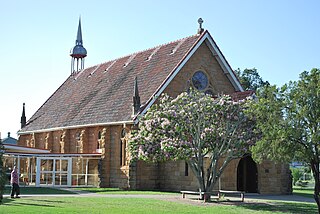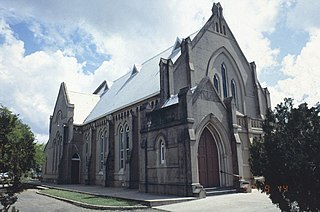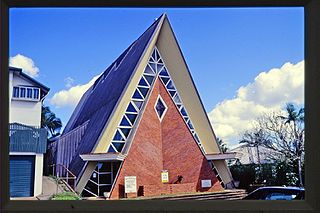
St Andrew's Uniting Church is a heritage-listed Uniting church at 131 Creek Street, Brisbane CBD, City of Brisbane, Queensland, Australia. It was designed by George David Payne and built in 1905 by Alexander Lind & Son. Initially St Andrew's Presbyterian Church, it became part of the Uniting Church following the merger of the Presbyterian, Methodist and Congregational Churches in 1977. It was added to the Queensland Heritage Register on 21 October 1992.

Christ Church Cathedral is a heritage-listed Anglican cathedral complex at Duke Street, Grafton, Clarence Valley Council, New South Wales, Australia. The cathedral was designed by John Horbury Hunt and built from 1874 to 1884 by Reynold Brothers (brickwork) and G. J. T. Lawson (woodwork). It is also known as Cathedral Church of Christ the King and Grafton Anglican Cathedral. The property is owned by the Anglican Diocese of Grafton. It was added to the New South Wales State Heritage Register on 14 March 2003.

Trinity Church is a Uniting church located at 72 St Georges Terrace in Perth, Western Australia. Commenced in 1893, the former Congregational church is one of the oldest church buildings in the City of Perth, and one of the few remaining 19th-century colonial buildings in the city.

St Peter's Anglican Church is a heritage-listed Anglican church located at 187-209 Princes Highway, St Peters, in Sydney, New South Wales, Australia. It is one of the oldest churches in Sydney. Designed by Thomas Bird, the church is sometimes referred to as St Peter's Church, Cooks River, as it is located in the Anglican Parish of Cooks River, New South Wales. The church is listed on the NSW State Heritage Register and on the Register of the National Estate.

St James Church is a heritage-listed Anglican church at 145 Mort Street, Toowoomba, Queensland, Australia. It was designed by Richard George Suter and built from 1869 to 1953. It is also known as St James Church of England. It was added to the Queensland Heritage Register on 28 July 2000.

Wesley Uniting Church is a heritage-listed former Uniting church at 54 Neil Street, Toowoomba, Toowoomba Region, Queensland, Australia. It was designed by Willoughby Powell and built from 1877 to 1924. It is also known as Wesleyan Methodist Church. It was added to the Queensland Heritage Register on 10 May 1997.

Ann Street Presbyterian Church is a heritage-listed Presbyterian church at 141 Ann Street, Brisbane City, City of Brisbane, Queensland, Australia. It was built in 1858 by Joshua Jeays, altered and extended in 1897 to a design by Alexander Brown Wilson with further extensions designed by Douglas Francis Woodcraft Roberts in 1936. The church was added to the Queensland Heritage Register on 21 October 1992.

Holy Trinity Church is a heritage-listed Anglican church at 141 Brookes Street, Fortitude Valley, City of Brisbane, Queensland, Australia. It is the second church on that site. It was designed by Francis Drummond Greville Stanley built from 1876 to 1877 by James Robinson. It was modified in 1920–1921, 1925 and 1929. It was added to the Queensland Heritage Register on 21 October 1992.

Warwick Uniting Church is a heritage-listed Uniting church at 37 Guy Street, Warwick, Southern Downs Region, Queensland, Australia. It was built from 1869 to 1922. It is also known as St Andrew's Presbyterian Church. It was added to the Queensland Heritage Register on 24 March 2000.

Uniting Church Central Memorial Hall is a heritage-listed church hall at 86 East Street, Ipswich, City of Ipswich, Queensland, Australia. It was designed by George Brockwell Gill and built from 1895 to 1895 by W Betts. It is also known as Congregational Sunday School. It was added to the Queensland Heritage Register on 9 July 1993.

St Stephen's Church and Hall, part of the Central Church parish and officially Central Presbyterian Church, Ipswich, is a heritage-listed Presbyterian church and associated churchyard at 22 Limestone Street, Ipswich, City of Ipswich, Queensland, Australia. The church was designed by Joseph Backhouse, built from 1865 to 1978, and added to the Queensland Heritage Register on 21 October 1992.

St Andrew's Presbyterian Church is a heritage-listed former Presbyterian church at 280 Bolsover Street, in the central business district of Rockhampton, Rockhampton Region, Queensland, Australia. The former church was designed by Voller & Graham in the Gothic Revival style and built from 1893 to 1926. The former church was added to the Queensland Heritage Register on 21 October 1992.

St Paul's Uniting Church is a heritage-listed Uniting church at 21 MacAlister Street, Mackay, Mackay Region, Queensland, Australia. It was designed by Walter Carey Voller and built from 1898 to 1918. It is also known as St Paul's Presbyterian Church. It was added to the Queensland Heritage Register on 21 August 1992.

St Andrew's Presbyterian Memorial Church is a heritage-listed former Presbyterian and Uniting church at 114 Rankin Street, Innisfail, Cassowary Coast Region, Queensland, Australia. The former church was designed by Eddie Oribin and built in 1961 by Andrew George Pepper in the Modernist organic style and was also known as St Andrew's Presbyterian Church. The former church was added to the Queensland Heritage Register on 12 December 2003.

Wesley Church is a Uniting church located on Duke Street, overlooking Princess Royal Harbour, in Albany in the Great Southern region of Western Australia.

St David's Uniting Church is a heritage-listed Uniting church and associated precinct at 51- 53 Dalhousie Street, Haberfield, Inner West Council, Sydney, New South Wales, Australia. It was designed by Simeon Lord, David Ramsay, William Munro, J. A. B. Campbell, Power, Adam, and Munning, Thomas Rowe, and Ferdinand Reuss and built from 1860 to 1900 by Williams, Ravers, Duffy and Cannon. It is also known as St. David's Uniting Church, St Davids Presbyterian Church Precinct and includes the St David's Sunday School/Yasmar School, Ramsay Vault and Ramsay Graveyard. The property is owned by the Uniting Church in Australia. It was added to the New South Wales State Heritage Register on 19 August 2003.

St Ambrose Church is a heritage-listed Anglican church at Myrtle Street, Gilgandra, Gilgandra Shire, New South Wales, Australia. It was designed by Louis R. Williams of North and Williams and built from 1921 to 1922 by J. D. Ryan. It is also known as Cooee Church and Church of St. Ambrose. The property is owned by the Anglican Property Trust Diocese of Bathurst. It was added to the New South Wales State Heritage Register on 28 January 2011.

Tryon Road Uniting Church is a heritage-listed Uniting church located at 33 Tryon Road in the Sydney suburb of Lindfield in the Ku-ring-gai Council local government area of New South Wales, Australia. It was designed by William Slade and built from 1914 to 1914 by W. 'Ossie' Knowles. It is also known as Lindfield Wesleyan Methodist Church. The property is owned by the Uniting Church in Australia. It was added to the New South Wales State Heritage Register on 19 September 2003.

The Trinity Uniting Church is a heritage-listed Uniting church located at 62 The Boulevarde, in the Sydney suburb of Strathfield in the Municipality of Burwood local government area of New South Wales, Australia. It was designed by George Sydney Jones & Harry Thompson and built from 1889 to 1890 by Thomas Hanley of Balmain. It is also known as Trinity Congregational Church. The property is owned by the Uniting Church in Australia. It was added to the New South Wales State Heritage Register on 19 September 2003.

St Stephen's Presbyterian Church and Manse, also known as Queanbeyan Presbyterian Church, is a heritage-listed Presbyterian church and manse at 2 Morisset Street, Queanbeyan, New South Wales, Australia. It was designed by Alberto Dias Soares (church) and James Barnet (manse) and built from 1872 to 1883 by Thomas Priest (stonemason), Thomas Jordan (carpenter), John Kealman (carpenter). The property is owned by Presbyterian Church of NSW Property Trust. It was added to the New South Wales State Heritage Register on 24 May 2019.





















